Let food be thy medicine and medicine be thy food ~ Hippocrates
My in-laws left yesterday for Kolkata after spending a month with us here in Dubai. The house seems so empty suddenly, along with the fridge. We had lunch and dinner with all the leftovers from my shashuri – ma-in-law’s cooking… a few pieces of traditional Bengali fish like Pabda (two more pieces to go), bandhakopir torkari, a cabbage dish, and the summer favourite aam daal – a sweet-sour lentil soup with raw mango. From today, our kitchen will stop showing any semblance to my ma-in-law’s Kolkata kitchen that’s always been aligned to how my shoshurmoshai – father-in-law wants/loves to eat. There will now be pastas and sandwiches with some occasional Bengali cooking over the weekend splattered with the nostalgic reminiscences of how much we overate the past one month. The sadness of their leaving is being compensated to an extent with all the wishes and love that are still pouring in for my birthday (which fell on this Thursday but the celebrations still continue). After a month of eating only Bengali food, with traditional fish preparations holding centre stage, I feel the sudden need to write a post on these lines… A-Z of Bengali fish. It’s also a note of thanks from my side, for the love I get from all of you and how you keep on embracing me unconditionally and repeatedly as a citizen of this world living in this cosmopolitan city, despite my constant proclamations of my Bengali roots.
I am making a home in Dubai …. 3,307 kms away from Bengal, raising two third culture kids and perpetually in a quasi Bengali state of being – I crave for dupurer ghum – afternoon siesta on a Sunday afternoon when all of Dubai are busy getting into the groove of the week with the first working day being Sunday! There’s also the myth (okay the pseudo-truth) that I can never get away from – the Bengali’s love for fish – maach, and sweets – mishti, that I have kind of embraced nowadays. In fact, I have started to relish the curiosity and the talks surrounding these two topics. On the hindsight, I didn’t grow up loving fish as much as I loved sweets. But I seriously – seriously do now, and that’s all because of the two decades of living away from Bengal and also the constant questions and queries that I get from so many people – via emails and messages and DMs – on the topic of FISH. Nowadays, I have started getting whatsapp messages too from strangers, asking for Bengali fish recipes and all that’s related to Bengali fish. ‘Didi, nomoshkar. Apni to Dubai-te onekdin achen. Ekhane Bangali maach paoaa jay/ Hello Sister! You are living in Dubai for a long time. Where can we get Bengali fish here?’ or ‘Please mind korben na eto raate message korchi bole. Ami Meenabazar-e dariye achi. Ekhane kothay Bangladeshi dokan jekhane ilish paoa jay?/ Please don’t mind me messaging so late. I am standing in Meenabazaar right now, where is the Bangladeshi shop here which sells the Ilish?’ From Non-Bengalis, the questions would be more on these lines… ‘Can you share the Bengali fish recipe – I have just bought some Rohu from Lulu!’ or ‘I heard you can have fish from breakfast through dinner!’ Friends, there’s no ONE Bengali fish recipe. And, yes, SOME Bengalis love fish but they don’t exactly brush their teeth in fish oil, although I wished they could (it’s high in omega and good for the skin, hair, heart and eyes), nor do they catch fish in their sleep. Also, we can’t eat fish like the bony Hilsa – the Ilissh, with our eyes closed, as we too are as prone to choking if we don’t concentrate on the fish bones while we eat, as much as any Non-Bengali. But I will let these myths persist. It works towards our advantage and as I say, let’s bask in the glory of our fishy and sweet heritage!
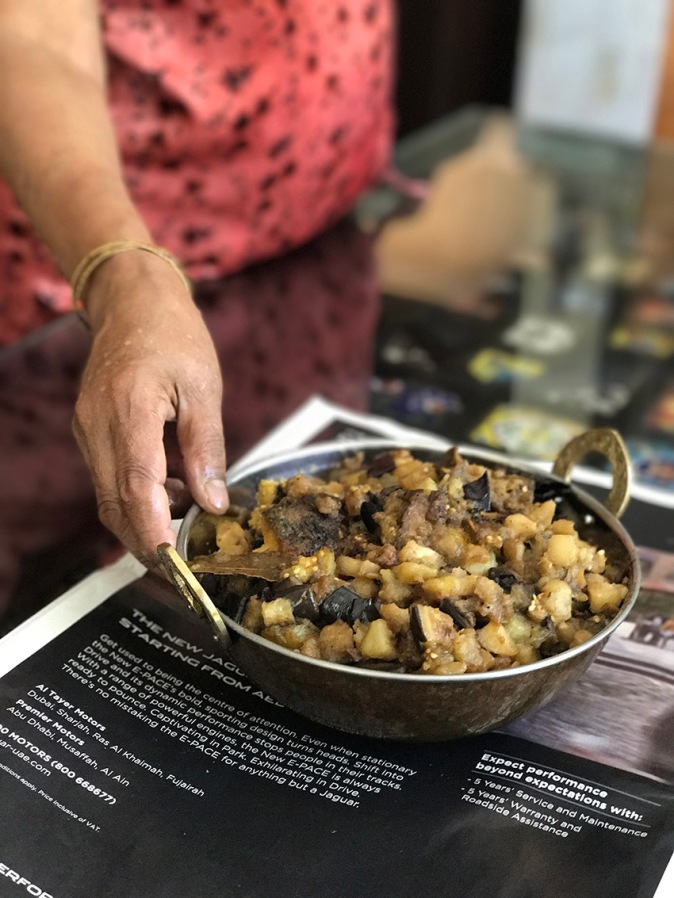
The special bhetki macher ghonto my shashuri made for my birthday – it’s a recipe from my side of the family that she took from my ma over the phone. A nostalgic recipe that ended up in transcending variations of cooking across borders and connecting two families together.
A conversation started over my birthday instastory where I have shared the Bhetki Macher Ghonto that I had for lunch (above). My day had started with payesh, the traditional rice pudding that ushers in every auspicious occasion for a Bengali… as early as 7:30 in the morning, made lovingly by my shashuri. Dinner was luchi and murgir jhol with aloo. As I hesitated a bit to explain my lunch – my exact words being… ‘Not mentioning the lunch which is a bit complicated to explain ~ ghonto if you know what I mean’, a sudden barrage of comments started pouring in. If you know, ghonto is more like a vegetable ratatouille with pieces of fish, fish head, tails and bones thrown in. I started receiving curious comments on Bengalis’ fish habits.
And a few knowledgeable Bengalis asked, how was I so sure that it was a ghonto and not a chyachra. For the uninitiated, these are complicated terms in Bengali culinary dictionary – preparations as different from macerated fruit to a poached one. I replied saying that my thamma (paternal grandma) used to make this ghonto and my ma picked it up from her. Since it’s my favourite, my ma-in-law who is visiting us, learnt the recipe from her over a long ISD call and made it for lunch – skype is banned in the UAE currently, hence the final product ended up being a very expensive ghonto. So, I know… this was a ghonto. Period!
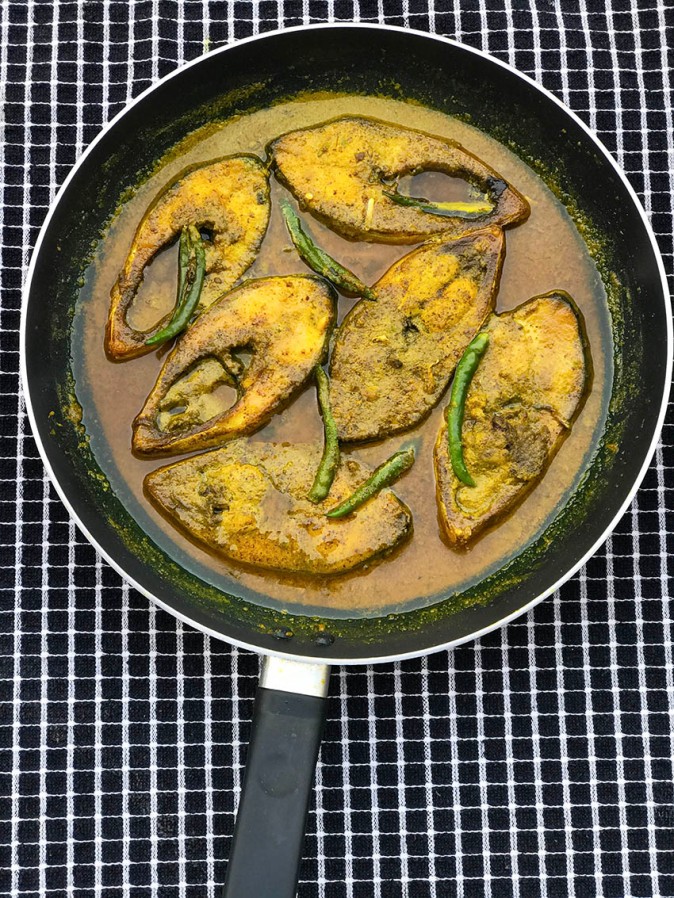
Shorshebata Iliish or the Mustard Hilsa, one of the most epic dishes from Bengali cuisine – with absolutely no filter! I often chat to my family how the food in my book should look like (if and when it materialises)… should it be stylised or should it be kept just like this… simple and homely? The poll feature in @instagram has been amazing in that sense and thank you for giving your verdict… 87% of you want to see the food like this… ready to attack!
With all the conversation relating or leading only to fish over the last one month with a freezer overflowing with Bengali fish starting from Aar to Bhetki to Chingri to Ilish to Pabda, stocked from the Bangladeshi supermarket (do read my post where you will get an idea to what extent we can go to get the right fish) … thanks to my shoshurmoshai who travels with a menu and routine that he is used to in his Saltlake home, I decided that this was probably going to be the best time to use my (fish) information overload. Also, the protagonist in the bone of contention between my shashuri and shoshurmoshai most of the times, is also the fish – what fish to cook – for lunch and then again for dinner, what preparation and how many pieces she should assign for him. At the dining table, our conversation then would revolve around whether the particular fish that has been cooked here, would taste better and fresher than the one he buys in the fish market and Kolkata. Don’t forget the prices – whether the dirhams spent here was worth the rupees that he generally spends back home. However, the Z-Sisters had the final say – apparently, our Dubai home apparently smelt like Saltlake when their Oma-Dadai when here! Kudos to Bengali fish bought in Dubai then… also, the A-Z of Bengali fish post couldn’t be avoided any longer.
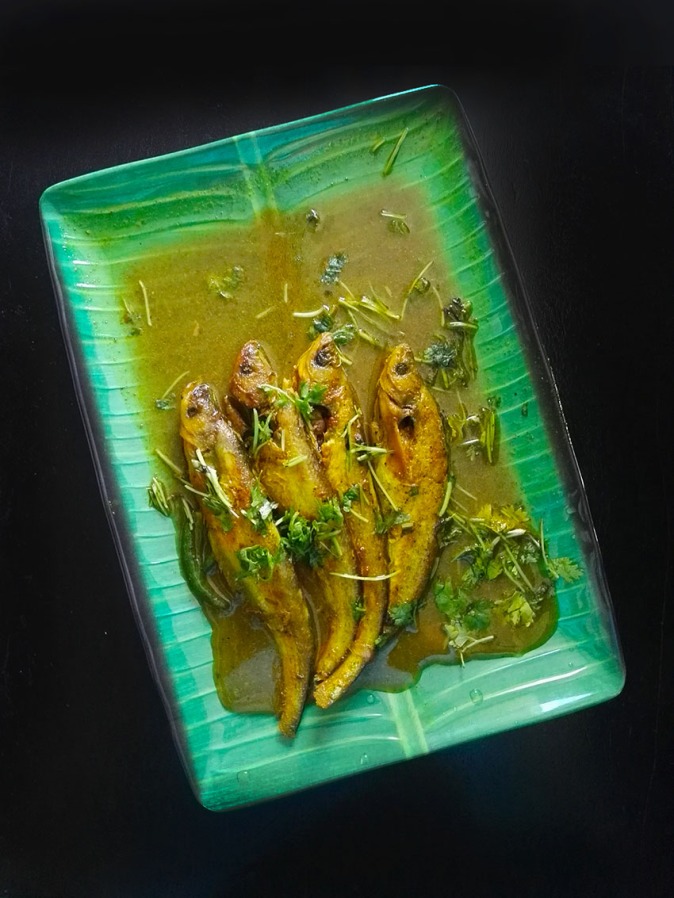
Pabda Maacher Jhol
A bit of a dig into my family history here… the preparations and availability of fish in Bengal in India and in Bangladesh is quite different. While my family is based more in Epar Bangla – the Indian side of Bengal, hence termed part-Ghotis and the Bearded Biker’s family is predominantly Bangals originating from Opar Bangla or Bangladesh, the fish preparations that we both have grown up eating are a bit different. My experience of fish eating had been limited to Rui, Iliish, Bhetki and Chingri and my marriage introduced me to a wider variety of fish and fish preparations. While we – the Ghotis can boast of a few iconic preparations like the Chingri Malaikari, the Bangals, as I discovered via my shashuri’s cooking, have a magic wand when it comes to cooking any fish. A simple fish gravy in black cumin paste from Opar Bangla can alone compete with all the elaborate fish kahlias and shorshebatas from Epar Bangla! As an ode to my heritage, here’s the list, A-Z of Bengali Fish and the best possible preparations for that particular fish… admitting that these are only the few where I have had the good fortune of laying my fingers on the fish bones, hence a few alphabets are still sitting empty.
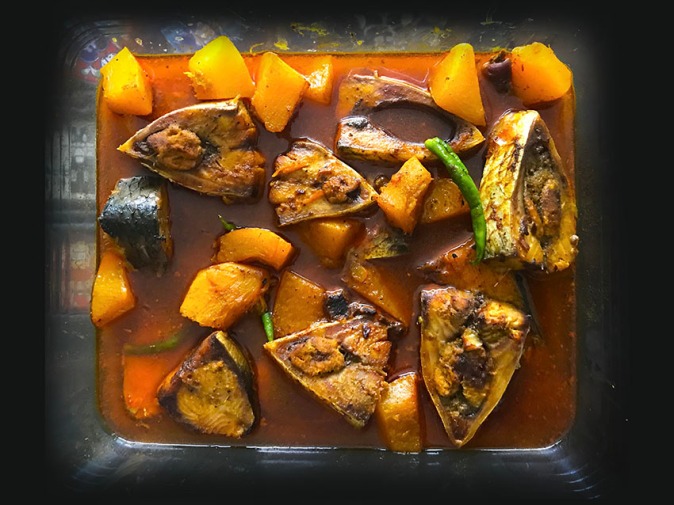
Ilish or Hilsa cooked in a light gravy of turmeric, black cumin and chilli with pumpkin. Sometimes, the pumpkin can be substituted by cucumber or eggplant – a preparation that I wasn’t familiar with before my marriage.
A-Z of Bengali Fish
A: Aar – less bones, delicate and very fleshy; Calls for a turmeric-black cumin gravy with aloo and slit green chillies, garnished with fresh coriander leaves.
B: Bata, Bhetki, Basa – While Bata is a long bony fish to be cooked in its entirety in the traditional mustard preparation with a tempering of nigella seeds, Bhetki is a well sought-after Bengali fish and versatile. One of its signature preparation is the Bhetki Paturi, where fillets are cooked in steam in a thick mustard and chilli paste while wrapped in banana leaves. Bhetki fillets are also coveted for the fish fry with an outer covering of breaded crumbs. Basa is one fish that is looked down upon by the Bengali fish snobs as a cheaper substitute for Bhetki fries, so beware!
C: Chitol, Chingri – It’s almost a dying art to scrape the flesh off the main spine so that they can be made into fish balls for the signature gravy – Chitol Maacher Muitha; also the Peti or the abdominal section of Chitol is exceptionally oily and calls for a gravy made with ginger, chilli, turmeric and white cumin. Chingri or the Prawn has many variations – depending upon the size. Galda, Bagda, Chyapra etc. Galda Chingri is the giant fresh water prawn and is most popularly used in the signature preparation – Chingrir Malaikari, a prawn preparation in coconut gravy. Bagda is the Tiger Prawn also used for Malaikari preparation while the Chapra is the smaller variety (both fresh and seawater) that goes well in a spicy fried preparation or as Chingrir bora or spicy fried balls.
D:
E: Eilish… see I!
F: Foli, Fyasha – Foli is more like Chitol while Fyasha is very bony. The former is tasty in a light turmeric, cumin and coriander gravy with vegetables like potatoes and snowpeas thrown in along with bori – fried lentil balls. Like many other Bengali fish, Like Foli, Fyasha is also a small fish that can be cooked in a mustard gravy.
G: Galda Chingri (see Chingri above), Gurjali – Interestingly, Gurjali has been referred as Indian salmon and is brilliant in a traditional mustard gravy with a tempering of nigella seeds.
H: Hilsa… see I!
I: Iilish – The fact that Ilish takes over three alphabets – E for Eilish, H for Hilsa and I for Ilish is not surprising as Ilish is indeed the celebrity Bengali fish. A topic for political debate involving two countries – India and Bangladesh – whether the Ilish from the Padma river in Bangladesh is better than the Ilish from the Ganges and vice versa. No fish has ever been commercialised so much or catapulted to such heights. Come monsoons, hotels and Bengali restaurants in Kolkata are flooded with Hilsa festivals where traditional recipes jostle for space along with fusion recipes. Amongst all the different recipes that exist, the ones that I love are the traditional ones – definitely the epic shorshebata or mustard fish preparation (I have a recipe for a similar preparation in salmon that praises to carry the same legacy), the patla kalojirer jhol – gravy made with black cumin and red chilli paste with either cubes of cucumber, or eggplants or pumpkin thrown in. I also can’t resist having simple fried Ilish with shada bhaat and Ilisher tel – steaming white rice with the oil that has been used to fry the fish pieces. My dida or maternal grandma also used to make a Ilisher Ombol, a sweet and sour chutney with Ilish in light tamarind and turmeric gravy with a tempering of mustard seeds. My ma has a signature recipe of a Ilish Maacher Raita, a yoghurt raita with Ilish, to be savoured cold. And of course, there is the Bhapa Ilish or the Steamed Hilsa, prepared wrapped in banana leaf.
J:
K: Katla, Koi, Kajli, Khoira – Katla comes from the family of Carp much like Rui, but in bigger size. Katla is used in the famous Kalia preparation, a rich oily preparation. Koi is famously prepared as Tel Koi in a mustard oil gravy, or as a Jhaal prepared with mustard paste and a tempering of nigella seeds.
L: Loite – Loite has different names and pronunciations in different parts of Bengal and is also known as the Bombay Duck in Mumbai. I Although there are recipes where Loite is cooked in a curry, I prefer the way my ma-in-law cooks it – Loite Maacher Jhuri… it’s time consuming and the end result is shockingly meagre in volume as compared to how it appears at the start. The constant stirring of the soft textured fish along with turmeric, red chilli, cumin and coriander lets the water from the fish to evaporate out and the mixture becomes crunchy and real spicy.
M: Mourola, Magur, Mrigal – I grew up hearing that tiny sized Mourola is good for the eyes but the way we have always had it probably defined the purpose… deep fried in oil! Magur is a kind of a catfish and small pieces of Magur cooked in a light gravy made with turmeric and cumin is considered a coolant. Mrigel is quite bony and cooked in a dense mustard gravy brings out the fine taste of the fish.
N/O:
P: Parshe, Pabda, Pona, Punti, Pangash – Parshe is best served in a jhal preparation in a mustard gravy, while Pabda can be cooked in a light jhol or a hot jhal, depending upon the size. Pona comes from the same family as Rohu and can be prepared in a similar way while Chara Pona, is the baby Pona and makes a very good light curry with potatoes, green papaya, green banana and Boris. Punti is one of the more popular small fish and is cooked in a jhaal, the dense mustard gravy. Pangash tastes amazing in a Dopiaza preparation which is not a traditional Bengali preparation. The Dopiaza is is a Middle Eastern preparation with a large amount of onions cooked in a thick tomato gravy.
Q:
R: Rui – Rui or Rohu is definitely the most popular fish used for day-to-day cooking and is available with ease. For example, this is the only Bengali fish that are quite easily available in regular Dubai supermarkets like Lulu or Carrefour. Rui is quite versatile and fleshy, and can be cooked in almost all the Bengali fish preparations that one can think of … jhol, jhal, kalia, doi maach and more (refer below for the definitions). A light gravy preparation of Rui with potatoes, cauliflower and green peas brings back memories of my Dida’s cooking – a nostalgic dish conjuring up the winters from my childhood.
S: Shingi, Shol, Shorputi – Cooked up in a light stew with seasonal vegetables like snow peas, eggplants, potatoes (but, of course), Shingi Maacher Jhol act as another coolant with high therapeutic with high nutritional quotients. While I have tasted Shol in a kalia preparation, there’s also a popular recipe where its cooked in a gravy with raw mangoes. Shorputi again, is another variation of Puti and can be cooked in a jhal or a jhol.
T: Tyangra, Tilapia, Topshe – Tyangra is great for a Jhal chochori – with fried Tyangras cooked in a spicy non-gravy preparation. Tilapia is an import and has been adopted affectionately into the Bengali fish dictionary and serves up brilliantly in a Shorshe Jhaal, the spicy mustard preparation. I have grown up seeing my parents and their friends serving Topshe fried in whole, in a gram flour batter sprinkled with either nigella seeds or posto – poppy seeds, as a starter to accompany their Sunday gin and vodka lunch parties, and I can’t seem to remember if I’ve ever tasted Topshe in any other way!
U/V/W/X/Y/Z:
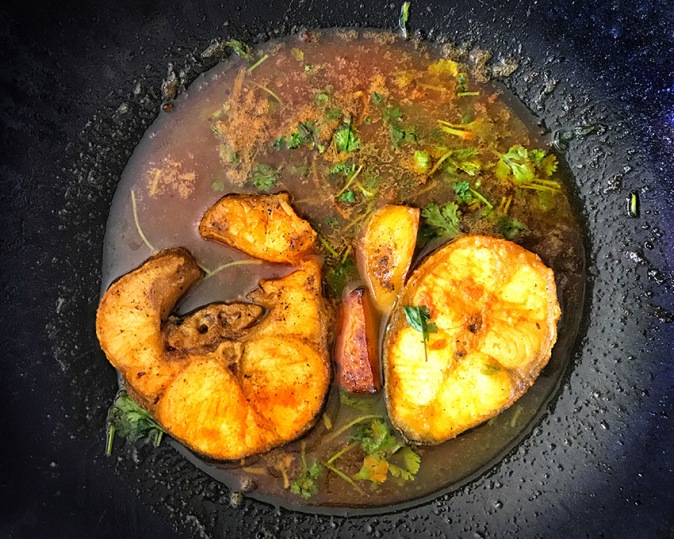
Aar prepared in jhol, a light gravy of turmeric and cumin with potato and fresh coriander leaves
When fish names can be so many, fish preparations must match up to the number… so we have ghonto and ghyat, chachra and lyabra, jhol and jhal. If this is of any interest to you, here you go…
Fish is still cooked daily for main course in most traditional Bengali household. Shorshe Maach/Mustard Fish is one of the most popular fish preparations and has found quite an acclaim outside the Bengali home, but it is not the only fish recipe in our pescetarian portfolio. Bengali cuisine is famous for it’s various fish preparations – and there is a lot going into the fish gravy on whether it should be called Maacher Jhol or Maacher Jhaal. Maacher Jhol is where the gravy of the dish is made with ginger, turmeric, cumin powder, green chillis (the ingredients vary from one region of Bengal to another) and Jhaal is where the gravy is hot and spicy and made with mustard paste, turmeric, chilli and other spices. Then there is the Doi Maach, the yogurt gravy with tomatoes and onion, and the Kalia, a rich oily gravy with a lot of prominence of onion, garlic, tomatoes and garam masala – once the mainstay of a wedding buffet. Fish oil, skin, bones, head and tail – everything can go into a dish… while fish head is considered auspicious and is served to the new bride as she is welcomed into her newly wedded family, the rest of the bony remnants also find their holy space into various delicacies either for special occasions or for a daily casual dish. Kata chocchori uses up the kata or the fish bones along with one or more varieties of vegetables or leafy greens cut into longish strips. In Chhyanchra fish head, bones and and fish oil are cooked along with different vegetables and appears more like a soft ratatouille. And then there is the Ghonto where chopped vegetables are cooked in phoron and spices with fish head and fish bones. Muri-ghonto is a particular delicacy where rice is cooked with fish head and bones. We don’t spare Daals too, and the tastiest one is Maacher Maatha diye Moong Daal, where fish heads and bones spruce up a dense moong daal, the yellow lentil soup. While all the above may sound a bit complicated for the uninitiated or even for many Bengalis, the expertise in determining whether a dish is a chyanchra or a chocchori and whether a gravy is a jhaal or a jhol, hits all Bengalis suddenly like puberty and adolescence… but it will definitely happen once in their lifetimes. For some, it hits earlier than others!

Katla cooked in a light gravy – jhol with potatoes, to be supplemented by steaming white rice. My shoshurmoshai still uses a similar plate made with Kansha, or bell metal, a hard alloy used for making bells and related instruments. Ancient Ayurveda attributes the use of different utensils to extract different nutrients and eating in a kansha plate or drinking water in a kansha glass has been an age-old tradition. Although I have inherited a few of these in my kitchen, I use them sparingly for a one-off photo shoot, succumbing to the demands of the modern day dishwasher!
Like any other cuisine in this world, no Bengali fish recipe is sacrosanct and no one recipe is better than the other. The usage of garlic, onion, tomatoes in some fish preparations may feel like a modern interpretation but if you dig in, you may find that they are as intrinsic part of a traditional recipe in some other region in Bengal. What perhaps remains sacrosanct is the use of mustard oil in a Bengali fish preparation and the use of fingers for bhaat mekhe khaoa – to mix the rice in the delicious fish gravy. If you refer to the picture above, you will realise how there can never be another option! Regional variations have co-existed through times and recipe evolutions can be contributed to geo-political changes that have shaped the history of Bengal – from the undivided Bengal of pre-independence India to the one that is now partitioned by the borders of India and Bangladesh, post-independence. My list here is not comprehensive, and it cannot be as my knowledge is limited by what I have tasted in the kitchens of only a few families – my father’s ancestral home in Naihati (very ghoti), my dida’s cooking (again ghoti as she was from Bhatpara), my ma’s very own style of cooking as she picked up recipes from both Naihati and Bhatpara, my ma-in-law’s cooking which has been influenced by her mother and reflects the Bangal way of cooking… and finally every other Bengali family that I have had a meal with – from the shores of California to Singapore, and from the time we made a home in Frankfurt to all the true-blue Bengali homes that we have visited in Kolkata.
I have deliberately used all the shots that capture traditional Bengali fish cooked in my kitchen in Dubai. I leave it at this, and am hoping that you will be filling me with more fish names and recipes. I am also curious to check what are the new Bengali Fish words that people have been searching in my blog over the weekend – once someone was looking for a ‘maach-boudi in Dubai’, I don’t really want to translate that here. I am just relieved that no body has called me a maach-didi – a fish sister, yet!
Unblogging it all… Ishita
Disclaimer: This isn’t a sponsored post, nor are there any affiliated links. The subject, story, opinions and views stated here are my own. While you enjoy reading my posts with lot of visuals, please do not use any material from these posts. Do join me on my daily food and travel journey on Instagram, Facebook, Twitter and Pinterest.
Read my other fish posts:
Shorshe Bata Maach – Mustard Salmon In This Case
Traditional Bengali Cuisine | All The ‘Slight’ Details


Hi Chotai,
Great research on Fish…
Actually I could get the aroma of the Ilish macher jhaal, aar maccher jhol, chingri macher malai curry and more…moner aar petter khide beregelo…
Macher head to tail including macher tel still remain the pride of Bengali cuisine as well their identity in cook books written e-par Bangla or o-par Bangla.
A Bengali baby begins the food journey with fish….and travels with FISH all through….
Enjoyed the FISH voyage…it was almost like a pilgrimage..
Cheers! Keep writing and keep shining!
LikeLike
Thank you Indranimashi for always saying such lovely thing about my writing. You all are such culinary inspirations – how can I ever forget the two shaads that you showered me with where you cooked every food that an aspiring Bengali mum can every ‘desire’! ‘FISH voyage…it was almost like a pilgrimage’… I feel really humbled. Incase you have forgotten, you are my perennial Luchi Mashi! and you have been featured here in my ode to luchi… https://ishitaunblogged.com/2013/02/18/luchi-featured-in-ahlan-gourmet-my-ode-to-phulko-luchi/
LikeLike
Unbelievable!!! Just an outstanding read. The only fish I could think of that has been left out is amodi Mach jaar chorchori kora hoye. But this one great post.
LikeLike
Thank you Madhushree for your warm words! I haven’t had Amodi, but if I can get a few more names I will surely add them to the post. Not to mention the Komola Katla!
LikeLike
What a great one on Fish! Such an interesting read
LikeLike
Thank you so much… hope not too much
information overload on Bengali fish?
LikeLike
Pingback: Kavtaradzes’ Khinkali in Pasanauri | Our best food memories in Georgia until now
Pingback: Shorshe Bata Maach – Mustard Salmon In This Case | A Detour From Thailand To Wish Shubho Noboborsho!
Pingback: Shubho Noboborsho | A traditional Bengali menu for Frying Pan Diaries podcast
Pingback: Traditional Bengali Cuisine | All The ‘Slight’ Details
What an awesome post! Love the details. My google search for bengali fish in dubai bought me here. We have just moved to Dubai. Stay in Bur Dubai area. Could you please guide us on where to buy these bengali fish . Any market or supermarket that you know of..thanks in advance
LikeLike
Thank you Neha, and welcome to Dubai! From Bur Dubai, there are many options. CitiMart on Rolla Road sell Ilissh and other Bengali fish flown from Mumbai. There’s another Bangladeshi supermarket just beside DreamGirls Tailors in Meena Bazaar who deliver home. Let me get back to you. The best buy would be at the Backet in Rolla Road in Sharjah – they are the largest wholesellers for all Bangladeshi supermarkets around this region.
LikeLike